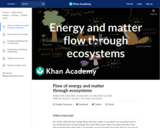
See how energy flows and matter is recycled in ecosystems.
- Subject:
- Biology
- Ecology
- Life Science
- Material Type:
- Lesson
- Provider:
- Khan Academy
- Provider Set:
- Khan Academy
- Author:
- Sal Khan
- Date Added:
- 08/25/2016

See how energy flows and matter is recycled in ecosystems.
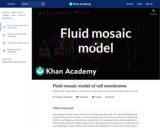
The fluid mosaic model describes the cell membrane as a tapestry of several types of molecules (phospholipids, cholesterols, and proteins) that are constantly moving. This movement helps the cell membrane maintain its role as a barrier between the inside and outside of the cell environments.
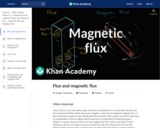
Introduction and intuition for flux and magnetic flux.
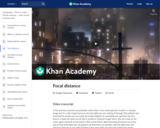
What happens if we change the distance between our aperture and image plane?
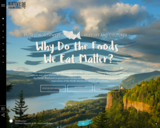
This online lesson provides perspectives from Native American community members, images, objects, and other sources to help students and teachers understand the efforts of Native Nations of the Pacific Northwest to protect and sustain salmon, water, and homelands. Scroll to begin an exploration of the Pacific Northwest history and cultures.

Food! is a freely available community research guide developed by the Smithsonian Science Education Center (SSEC) in partnership with the InterAcademy Partnership as part of the Smithsonian Science for Global Goals project. These Smithsonian Science for Global Goals community research guides use the United Nations Sustainable Development Goals (SDGs) as a framework to focus on sustainable actions that are defined and implemented by students.
Food! is a module broken up into seven parts. Each part contains a series of tasks to complete. Each task contains additional resources to support that task. We have provided a suggested order for the parts and tasks. However, the structure of the guide hopefully allows you to customize your learning experience by selecting which parts, tasks, and resources you would like to utilize and in what order you would like to complete them.

In this adaptation of a video that high school students created in collaboration with the Environmental Justice League of Rhode Island, learn what's whack about our current food systems and the many actions individuals can take to address these issues.
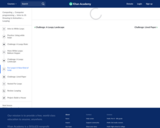
An introduction to recursion in coding.
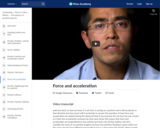
What's the different between a wind force and the force due to gravity? This video covers both Newton's second law of motion and law of gravity.
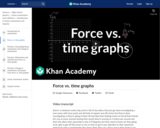
David explains how to use a force vs. time graph to find the change in momentum and solves an example problem to find the final velocity of a spaceship. Created by David SantoPietro.
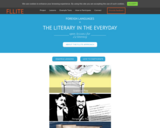
The FLLITE website contains a collection of lessons in second language literacy for various languages.
The website is the focal point of the FLLITE Project, which takes the creative moments found in everyday language use as the basis for lessons in second language literacy. By emphasizing language play as central to communication, FLLITE lessons aim to develop language awareness as well as communicative abilities through the integration of speaking, reading, listening, and writing tasks.
The goal of the FLLITE Project is the publication of classroom-tested lessons based on authentic texts in different languages, for example, blogs, Internet memes, YouTube videos, slam poetry, and so forth.
All FLLITE lessons carry an open license that allows you the teacher to…
…access, adapt, and re-use any lesson; and
…contribute a lesson for editorial feedback and publication.
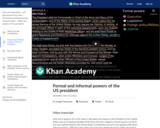
Formal and informal powers of the US president.
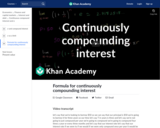
Learn how to calculate interest when interest is compounded continually. We compare the effects of compounding more than annually, building up to interest compounding continually. Created by Sal Khan.
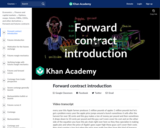
Forward Contract Introduction. Created by Sal Khan.

This video segment adapted from NOVA shows how scientists use the fossil record to trace when early human ancestors and related species began walking on two legs instead of four, and to determine whether they were more apelike or human in appearance.

Studio C (very funny sketch comedy channel hosted by BYU) skit on the founding fathers as a fraternity. Short funny video on the founding fathers. Can be used as an introductory activity.
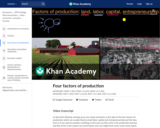
Economists traditionally divide the factors of production into four categories: land, labor, capital, and entrepreneurship. Land refers to natural resources, labor refers to work effort, and capital is anything made that is used to make something else. The last resource, entrepreneurship, refers to the ability to put the other three resources together to create value. In this video, we define each of the four factors of production and provide examples of each.
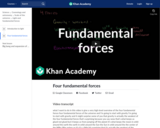
An introduction to Gravity, Weak, Electromagnetic and Strong Forces. Created by Sal Khan.
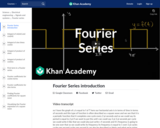
The Fourier Series allows us to model any arbitrary periodic signal with a combination of sines and cosines. In this video sequence Sal works out the Fourier Series of a square wave. Created by Sal Khan.
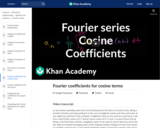
Fourier coefficients for cosine terms. Created by Sal Khan.